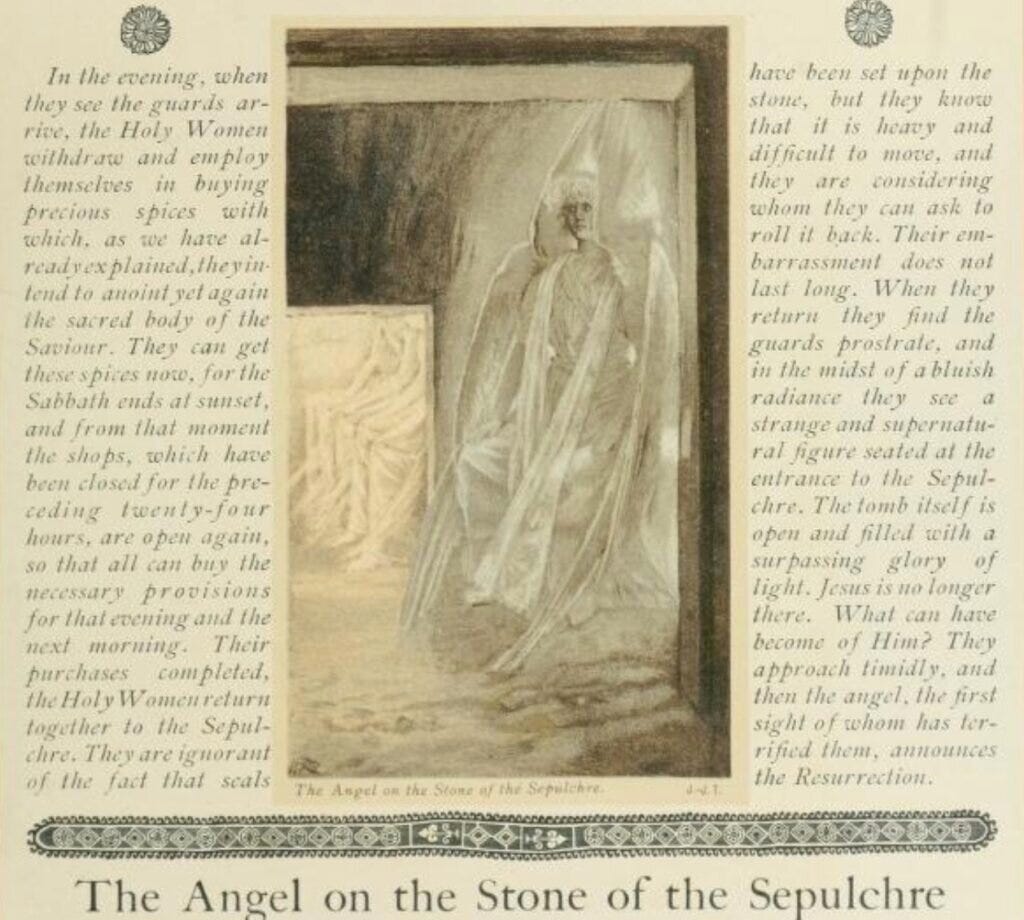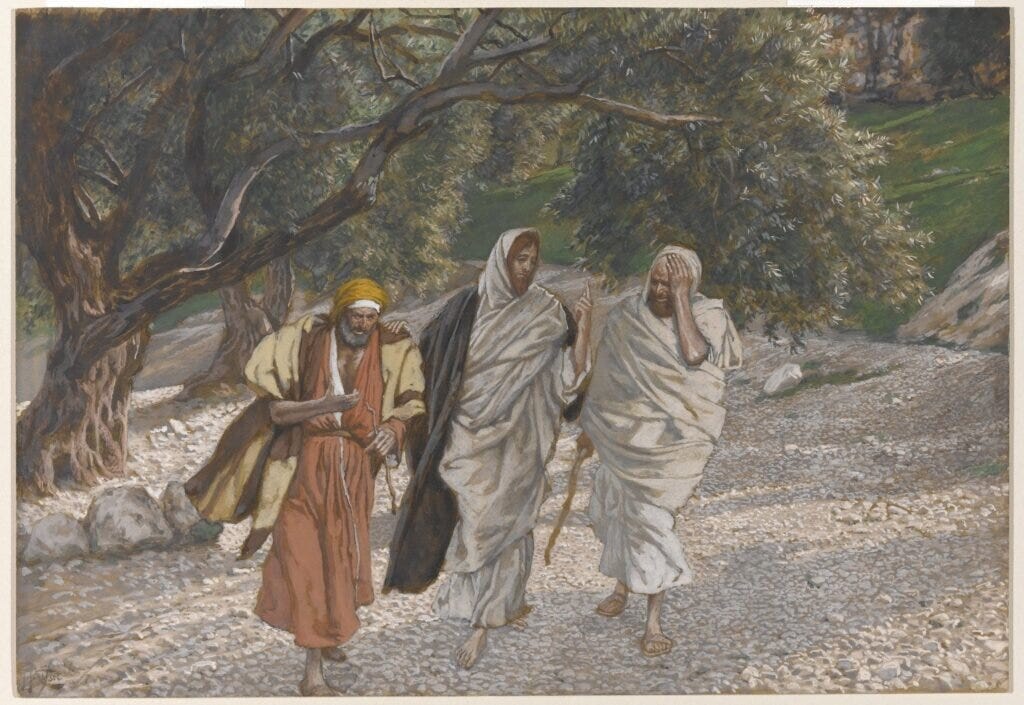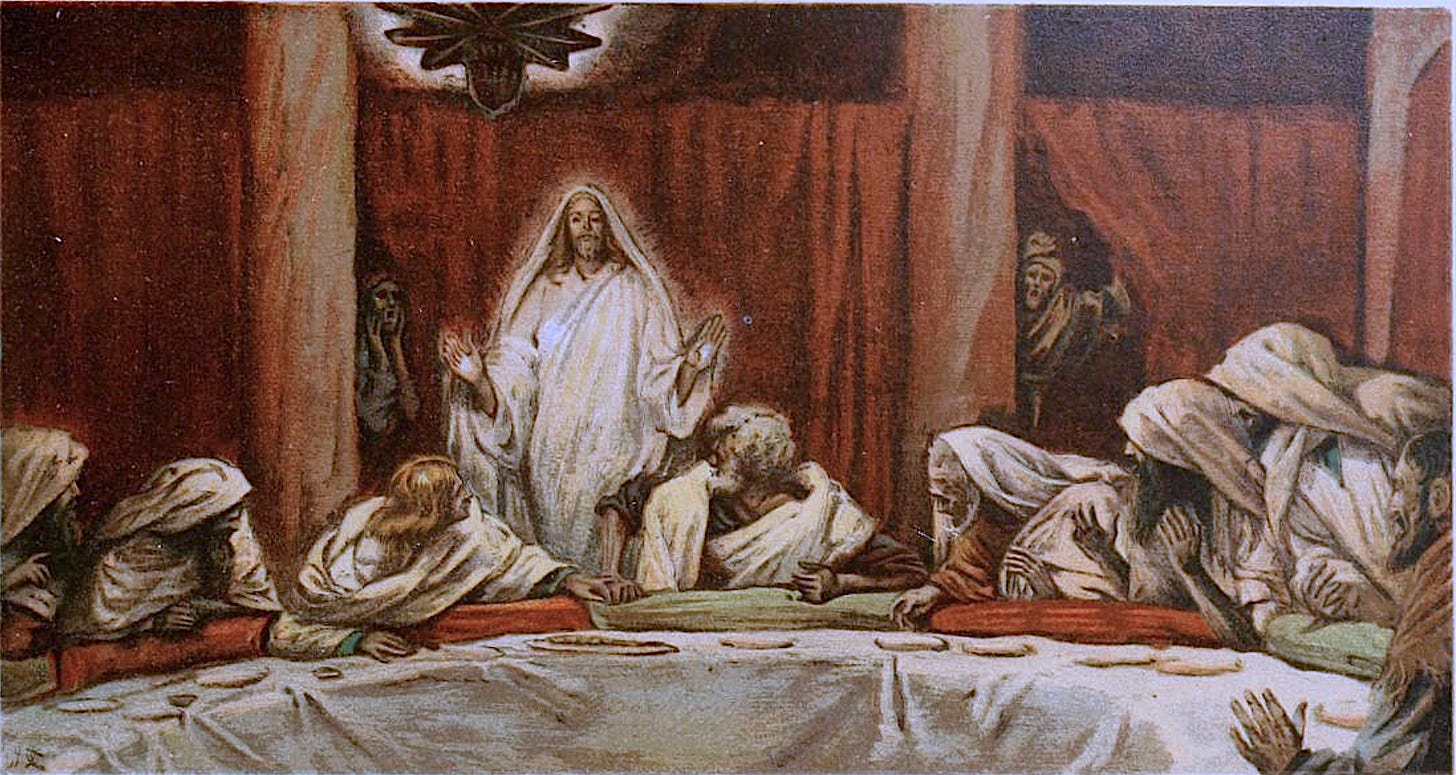Easter Sunday, Pascha, or Sunday of the Resurrection, Illustrated, with Scriptures and Commentary
By James Tissot and Dom Guéranger
The following illustrations with quotations from the Douay Bible and Tissot’s commentary are on this page:
+ The Resurrection
+ Mary Magdalene and the Holy Women at the Tomb
+ The Angel Seated upon the Stone of the Tomb
+ Disciples on Their Way to Emmaus
+ Christ appears to the Eleven as they sit at meat
These illustrations and commentary are from Volume IV in The Life of our Saviour Jesus Christ: three hundred and sixty-five compositions from the four Gospels. You can see the main illustrations (and supplemental illustrations) and read all of Tissot’s extensive commentary for free at the above link at the Internet archive. The meditations in Tissot’s commentary were based on the Scriptures and the visions of Blessed Anne Catherine Emmerich of Christ’s life.
Dom Prosper Guéranger’s commentary on Easter Sunday: “And while this Jesus, this Man-God, thus breaks the sceptre of death, the stillness of the night is undisturbed. His and our victory has cost him no effort. O death! where is now thy kingdom? . . . The tomb thou makest for us will become to us the source of a new life, for he that now conquers thee is ‘the First-born among the dead’; and to-day is the Pasch, the Passover, the deliverance, for Jesus and for us his brethren. He has led the way; we shall follow; and the day will come when thou, the enemy that destroyest all things, shalt thyself be destroyed by immortality. Thy defeat dates from this moment of Jesus’ Resurrection, and with the great Apostle we say to thee: ‘O death! where is thy victory? O death! where is thy sting?’ . . .
“As when our Jesus expired upon the Cross, so now immediately after his Resurrection, an earthquake shook the foundations of the world; but this time it was for joy. ‘The angel of the Lord descended from heaven, rolled back the stone, and sat upon it. And his countenance was as lightning, and his raiment as snow. And for fear of him the guards were struck with terror,’ and fell on the ground ‘as dead men.’ God has mercy on them; they return to themselves, and quitting the dread sepulchre, they hasten to the city, and relate what they have seen.
“Meanwhile, our risen Jesus, seen by no other mortal eye, has sped to his most holy Mother. He is the Son of God; he is the vanquisher of death; but he is likewise the Son of Mary. . . . The Gospel does not relate the apparition thus made by Jesus to his Mother . . .. There was no need of its being mentioned in the Gospel; the tradition of the holy Fathers, beginning with St Ambrose, bears sufficient testimony to it; and even had they been silent, our hearts would have told it us. . . . Such is the teaching of many pious and learned writers; and who that knows aught of Jesus and Mary could refuse to accept it?
But who is there would attempt to describe the joy of such a meeting? Those eyes that had grown dim from wakefulness and tears now flash with delight at beholding the brightness which tells her Jesus is come. He calls her by her name; not with the tone of voice which pierced her soul when he addressed her from the Cross, but with an accent of joy and love, such as a son would take when telling a mother that he had triumphed. The Body which, three days ago, she had seen covered with Blood and dead, is now radiant with life, beaming with the reflections of divinity. He speaks to her words of tenderest affection, he embraces her, he kisses her. Who, we ask, would dare to describe this scene, which the devout Abbot Rupert says so inundated the soul of Mary with joy that it made her forget all the sorrow she had endured? . . .
“In one of the revelations granted to the seraphic St Teresa, our Lord told her that when he appeared to his blessed Mother immediately after his Resurrection, he found her so overwhelmed with grief that she would soon have died; that it was not until several moments had passed that she was able to realize the immense joy of his presence; and that he remained a long time with her, in order to console her. . . . .
“His first visit was to her who is the dearest to him of all creatures, and who well deserved the favour; now, in his goodness, he is about to console those devoted women, whose grief is, perhaps, too human, but their love is firm, and neither death nor the tomb have shaken it. . . .
“Before the day is over, Jesus will show himself to them whom he has chosen as the heralds of his glory; but he first wishes to honour those generous women who, braving every danger, and triumphing over the weakness of their sex, were more faithful to him, in his Passion, than the men he had so highly honoured as to make them his Apostles. . . .
“There is in it a mysterious feeling of joy unlike that of any other day throughout the year: no one can resist it, not even the coldest heart. The infidel who scoffs at the believer knows at least that this is Easter Sunday. Yea, in the very countries where paganism and idolatry are still rife, there are Christians whose voices unite with ours in singing the glorious Alleluia to our risen Jesus. Let us then cry out as Moses did, when the Israelites had crossed the Red Sea, and were keeping their first Pasch: ‘Who, O Lord, is like unto thee, among the strong?
The Resurrection
“St. Matthew 28:1-4: “And, behold, there was a great earthquake: for the angel of the Lord descended from heaven, and came and rolled back the stone from the door, and sat upon it.
“His countenance was like lightning, and his raiment white as snow.
"And for fear of him the keepers did shake, and became as dead men."
Tissot’s commentary: “The glorified Christ escapes from the tomb; silently He rises. His wounds shining luminously. His body, now triumphant over death, no longer subject to the laws to which it had previously submitted.”
The Angel Seated upon the Stone of the Tomb
Tissot commentary: “Saint Matthew attributes the earthquake which took place at the Resurrection to the descent of the angel of the Lord from Heaven, and certain early commentators take this as a proof that the angel in question was Gabriel, who had announced to Mary the coming birth of Christ. Gabriel does, in fact, signify the power of God, and for that reason it would seem to be peculiarly appropriate that he should be associated with the Resurrection, that work of sovereign might. Moreover, add these doctors, it was fitting that the same angel should announce to the world the two births of the Son of Man: that to life on earth and that to life on high. There can be no doubt, they say. that many other celestial spirits were also present though invisible.”
Mary Magdalene and the Holy Women at the Tomb
St. Mark 16: 1-6: "And when the sabbath was past, Mary Magdalene and Mary, the mother of James, and Salome, had brought sweet spices, that they might come and anoint him.
“And very early in the morning of the first day of the week, they came unto the sepulchre at the rising of the sun. And they said among themselves, 'Who shall roll us away the stone from the door of the sepulchre?'
"And when they looked, they saw that the stone was rolled away: for it was very great.
“And entering into the sepulchre, they saw a young man sitting on the right side, clothed in a long white garment, and they were affrighted.
"And he saith unto them, 'Be not affrighted: Ye seek Jesus of Nazareth, which was crucified: he is risen; he is not here; behold the place where they laid him.’"
Tissot commentary: “After the Entombment of Christ the Apostles lived together: their anxiety shared by all the friends of Jesus, kept 'them assembled in one house. They waited in the Guest-Chamber or rather they hid themselves there, dreading discovery and further persecution This night, especially, must have been agitated by vague presentiments, when they remembered certain mysterious words of the Master. Suddenly, on Sunday morning, that is to say on the day following the Sabbath, hasty knocks are heard at the door. Who can it be? What is happening? Are they to be arrested? Is the persecution of the disciples to be continued and must they flee again? Saint Peter and Saint John, who are more affectionately anxious and more eager about the Master than the others, are the first to open the door. It is Mary Magdalene who waits without; she rushes in like a hurricane, and, standing panting for breath on the threshold, she flings out the words without approaching nearer to the Apostles: ‘They have taken away the Lord out of the sepulchre, and we know not where they have laid him.’ She is blinded by agitation. As long as Jesus was still there, living or dead, she could manage to control her grief and deceive herself, but now that He is gone, she becomes quite mad; she must find Him at all costs, and she hurries back to the Sepulchre, followed by most of her companions.
Mary Magdalene runs and tells the disciples
Saint Peter and Saint John Run to the Sepulchre
Mary Magdalene Questions the Angels in the Tomb
Jesus Appears to Mary Magdalene
Do Not Hold on to Me (Noli me tangre)
Jesus Appears to the Holy Women
Disciples on Their Way to Emmaus
St. Luke 24:13-32: "And behold, two of them went, the same day, to a town which was sixty furlongs from Jerusalem, named Emmaus. And they talked together of all these things which had happened. And it came to pass, that while they talked and reasoned with themselves, Jesus himself also drawing near, went with them.
"But their eyes were held, that they should not know him. And he said to them: 'What are these discourses that you hold one with another as you walk, and are sad?' And the one of them, whose name was Cleophas, answering, said to him: 'Art thou only a stranger to Jerusalem, and hast not known the things that have been done there in these days?' To whom he said: 'What things?' And they said: Concerning Jesus of Nazareth, who was a prophet, mighty in work and word before God and all the people; And how our chief priests and princes delivered him to be condemned to death, and crucified him.
"But we hoped, that it was he that should have redeemed Israel: and now besides all this, today is the third day since these things were done. Yea and certain women also of our company affrighted us, who before it was light, were at the sepulchre, And not finding his body, came, saying, that they had also seen a vision of angels, who say that he is alive. And some of our people went to the sepulchre, and found it so as the women had said, but him they found not. ' Then he said to them: 'O foolish, and slow of heart to believe in all things which the prophets have spoken.'
"'Ought not Christ to have suffered these things, and so to enter into his glory?' And beginning at Moses and all the prophets, he expounded to them in all the scriptures, the things that were concerning him. And they drew nigh to the town, whither they were going: and he made as though he would go farther. But they constrained him; saying: 'Stay with us, because it is towards evening, and the day is now far spent.' And he went in with them. And it came to pass, whilst he was at table with them, he took bread, and blessed, and brake, and gave to them."And their eyes were opened, and they knew him: and he vanished out of their sight. And they said one to the other: 'Was not our heart burning within us, whilst he spoke in this way, and opened to us the scriptures?'"
Tissot’s commentary: “‘It would be difficult,’ says Renan, ‘to add one word to this account, one of the most refined and delicately shaded in any language.’ St. Luke, the painter and psychologist, can be easily recognized in it, and nearly all the details of the narrative are given by him alone. Saint Mark merely makes a general statement of the fact: ‘After that he appeared in another form to two of them as they walked, and went into the country. And they went and told it unto the residue: neither believed they them.’”
“Jesus remained longer with the disciples on the road to Euvuaus than on any other occasion after His resurrection. As a rule. He showed Himself but for a few instants, said a few words, scarcely allowing anyone to touch Him, but this time He walked with the Apostles for an hour. They laid their hands on His shoulders, they listened to His voice and were touched by His words, yet He seemed to them so much like any other man that they invited Him to supper. He accepted, went in with them and ‘sat down to meat’. How was it that, seeing Him in so tangible a form before them, they did not recognise Him? ‘Their eyes were holden’, says the sacred text. On other occasions it was as He appeared that He made Himself known, now it was as ‘He vanished out of their sight’ that He revealed Himself. This sudden disappearance opened their eyes more fully even than the breaking of the bread which first led to their recognition of the divine Master.”
Christ appears to the Eleven as they sit at meat
Saint Luke 24:33-53 “And rising up, the same hour, they went back to Jerusalem: and they found the eleven gathered together, and those that were staying with them, Saying: The Lord is risen indeed, and hath appeared to Simon. And they told what things were done in the way; and how they knew him in the breaking of the bread.
“Now whilst they were speaking these things, Jesus stood in the midst of them, and saith to them: Peace be to you; it is I, fear not. But they being troubled and frightened, supposed that they saw a spirit. And he said to them: Why are you troubled, and why do thoughts arise in your hearts? See my hands and feet, that it is I myself; handle, and see: for a spirit hath not flesh and bones, as you see me to have. And when he had said this, he shewed them his hands and feet.
“But while they yet believed not, and wondered for joy, he said: Have you any thing to eat? And they offered him a piece of a broiled fish, and a honeycomb.
“And when he had eaten before them, taking the remains, he gave to them.
“And he said to them: These are the words which I spoke to you, while I was yet with you, that all things must needs be fulfilled, which are written in the law of Moses, and in the prophets, and in the psalms, concerning me.
“Then he opened their understanding, that they might understand the scriptures.
“And he said to them: Thus it is written, and thus it behoved Christ to suffer, and to rise again from the dead, the third day: And that penance and remission of sins should be preached in his name, unto all nations, beginning at Jerusalem. And you are witnesses of these things. And I send the promise of my Father upon you: but stay you in the city till you be endued with power from on high. And he led them out as far as Bethania: and lifting up his hands, he blessed them.
The Holy Ghost is "the promise of my Father,” the Comforter Christ had promised that He and His Father would send in John 14. 26, and 17. 7.
“And it came to pass, whilst he blessed them, he departed from them, and was carried up to heaven. And they adoring went back into Jerusalem with great joy. And they were always in the temple, praising and blessing God. Amen.”
Previous:
Overview:
You can sign up to get an email for each day on the history behind the Roman Catholic Church’s feasts and seasons from Dom Prosper Guéranger’s 15-volume series, The Liturgical Year here.
For a more-complete introduction to the amazing unclassifiable works of the complex and unique artist James Tissot, you might want to read this article “Contrasting Visions Of Painter James Tissot, The Secular And Sometime Mystical Realist.”
The images in this series are downloaded from the Brooklyn Museum. "RIGHTS STATEMENT: No known copyright restrictions."









